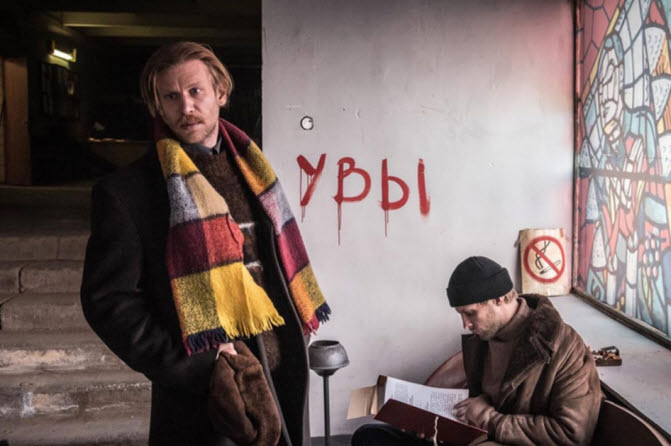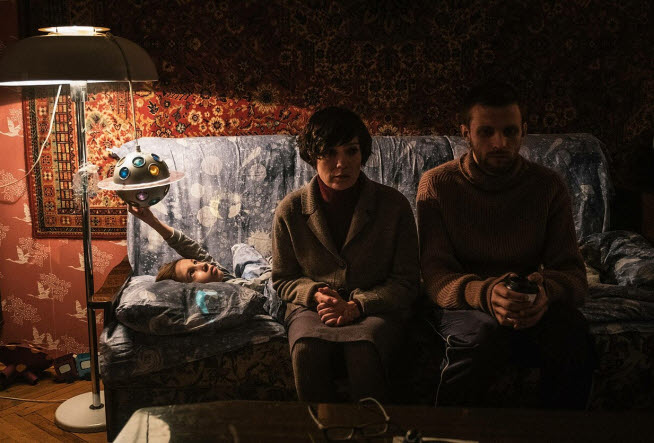Kirill Serebrennikov’s “Petrov’s Flu” is a boldly self-indulgent mess you may admire for good reasons. Mainly revolving around one plain hero who happens to have a serious case of flu, the movie freely and whimsically goes back and forth between reality and fantasy, and there are a number of visually striking moments to be savored, but you may also often scratch your head on what is actually about. To be frank with you, even I do not know how to describe its plot and characters to you on clear terms, so I will simply write down what I observed from the film.
The opening scene of the movie shows its titular character, Petrov (Semyon Serzin), being inside an urban bus along with many other passengers during on winter day. He is going to an apartment where his ex-wife and their son live, but he is not so well now because of recently having a flu, and his miserable current status is more exacerbated by a series of grumblings from a number of different figures around him inside the bus.
Some time later, Petrov’s ride is unexpected interrupted by a vehicle coming behind the bus. The vehicle belongs to a guy named Igor (Yuri Kolokolnikov), and Igor subsequently has Petrov get off from the bus and then join him inside the vehicle, which turns out to be a makeshift hearse. After an absurd moment involved with the coffin inside the vehicle, Igor takes Petrov to his workplace, and things become more absurd as Petrov finds himself hopelessly and miserably stuck with Igor and his colleague.
The movie also pays attention to the equally melancholic daily status of Petrov’s ex-wife Nurlinsa Petrova (Chulpan Khamatova), who incidentally works as a local library employee. For some unknown reason, she can suddenly be quite dangerous to others around her whenever she becomes quite exasperated, and we see how things can be very bloody when she becomes really angry to one rude attendee of a small poetry meeting held at her workplace.
In case of her son, he and Nurlinsa are not particularly friendly to each other. While Nurlinsa has been quite estranged from her ex-husband, her son still wants his father to take him to some holiday celebration event, even though he becomes rather ill probably because of that flu. While she actually feels a murderous urge at one point, Nurlinsa tries to tolerate her son as much as possible, though he does not appreciate her efforts much.
Meanwhile, Petrov’s state of mind becomes more feverish due to his worsening medical condition, and the movie deliberately blurs the line between reality and fantasy more than before. In case of one sequence, Petrov finds himself spending some time with a writer friend of his, and the situation becomes a bit amusing when Petrov finds that his friend’s latest work contains a surprising moment of sexuality. Not so pleased about this for a personal reason, Petrov and his writer friend argue with each other for a while, and then there comes another absurd moment between them as cinematographer Vladislav Opelyants’ camera fluidly hangs around them (Opelyants deservedly received the Vulcan Award for cinematography when the movie was premiered at the 2021 Cannes Film Festival, by the way).
Around this point, you will be quite baffled to say the least, and the movie keeps throwing more baffling moments as if it were following a stream of ill consciousness inside its hero who remains rather elusive to us to the end. For instance, we never get to know that much about him beyond his very sick condition, and you may not be entirely sure about whether he is a mechanic or a graphic novel artist or both.
While nothing is clarified enough on the whole, the movie goes further during its last act, which is incidentally presented in black and white film. We get to know more about a certain female figure briefly appearing in the middle of the film, and there are some moments of poignancy, but then you may also wonder whether this part is actually a story imagined inside Petrov’s mind. This will probably make you more distant to the story and characters than before, and you will not be that impressed much when the movie tries to catch you off guard again during its final scene.
Overall, “Petrov’s Flu” is admirable to some degree for how Serebrennikov and his cast and crew members try to do as much as possible during its rather long running time (147 minutes), but it was a frustrating experience for me as I often failed to sense and then hold onto any kind of emotional narrative inside the film. As I told you many times before, I do not mind getting baffled and disoriented at all, but “Petrov’s Flu” lacks the emotional center to engage and then touch me, and that makes me less inclined to give it a second chance later.
Anyway, “Petrov’s Flu” reminds me again that Serebrennikov is an interesting Russian filmmaker who willingly takes a chance with his artistic vision. I admired his previous works “The Student” (2016) and “Leto” (2018), and, despite his recent serious clash with the Russian government, he has already moved onto “Tchaikovsky’s Wife” (2022) and “Limonov: The Ballad” (2024). While I did not like “Petrov’s Flu” enough, I am already ready for these next two films of his, and I sincerely hope that I will be more impressed and entertained.










